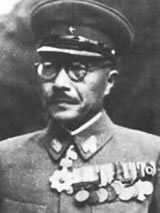 |
| Hideki Tojo |
On December 7, 1941, Japan preemptively attacked the US naval base at Pearl Harbor, Hawaii, destroying the Battleships Arizona and Oklahoma among other vessels. The following day, America declared war on Japan, followed by declarations of war against Germany and Italy, the other Axis powers.
Meanwhile, Japan occupied Thailand and struck the Philippines, Malaya, the Dutch East Indies, Hong Kong, various Pacific Islands, and elsewhere.
Throughout the 1930s, Japan strengthened her military and extended her presence on mainland Asia. By the end of the decade, Japan cast her interest southward to the poorly defended French, English, and Dutch colonies in Southeast Asia and the East Indies. In September 1940, the Rome-Berlin-Tokyo Axis was signed, offering Japan dominance in East Asia. It was Hitlerís intent for Japan to conquer Singapore and to gain control of the Straights of Malacca, the sea lane between the Pacific and Indian Oceans.
Prior to the Pearl Harbor attack, the American public expressed little interest in entering the European war, yet the USA did aid the British through the lend-lease of warships and airplanes and by occupying naval bases in Greenland and Iceland, thereby securing the North Atlantic sea lanes. And, in the Pacific, the USA announced its determination to defend the Dutch East Indies, its source of vital raw materials such as rubber. Then, in the summer of 1941, when Japan secured bases in French Indo-China and began moving troops and war materiel there, President Roosevelt froze Japanís assets in the USA, and limited shipments of oil from the Dutch East Indies to Japan.
Both countries claimed to seek a peaceful resolution to these territorial conflicts, but the US demands were beyond what the Japanese would accept. In October 1941, General Hideki Tojo became Prime Minister of Japan. While feigning negotiations with America, Tojo ordered his military to preemptively attack across a wide front, knowing full well this meant all out war with America. Japanís initial successes were staggering, but they did not achieve a knock-out blow.
History records what happened next. In less than four years, the USA and the Allies thoroughly defeated the powerful Axis in Africa, Europe, and the Pacific, forcing their unconditional surrender.
Published previously in an earlier website, July 4, 2003.
XXX

